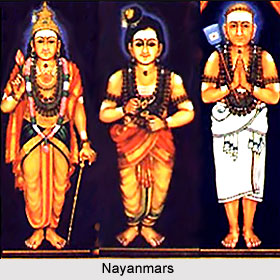 The influence of Bhakti Movement on Tamil Literature was noticed in the period after the Sangam age and the period of Ethical Tamil literature. The Bhakti movement initiated in ancient Tamil Nadu and later to spread to the northern India, during the late medieval ages. In the south India, Bhakti Movement centred on both Lord Shiva and Lord Vishnu in all his incarnations.
The influence of Bhakti Movement on Tamil Literature was noticed in the period after the Sangam age and the period of Ethical Tamil literature. The Bhakti movement initiated in ancient Tamil Nadu and later to spread to the northern India, during the late medieval ages. In the south India, Bhakti Movement centred on both Lord Shiva and Lord Vishnu in all his incarnations.
Bhakti Movement
Bhakti movement was mainly a Hindu religious movement led by the Shaivite and Vaishnava saints. Apparently, the Hindu religious leaders were worried about the increasing reputation of the Buddhists and the Jains. This led to the immoderate language and the determined systematic techniques implemented by the leaders of the Bhakti movement.
The Bhakti movement in the Tamil country was initiated by the 63 Nayanmars (Shaivite devotees) and the 12 Alvars (Vaishnavite devotees), who overlooked the asceticism preached by Buddhism and Jainism and rather advocated personal devotion to God for salvation.
Bhakti Movement and Spreading of Tamil Literature
The saints, which even included women, spoke and wrote in vernacular languages such as Tamil and Telugu. The saints traversed through out the country to preach the message of devotion and love among people, irrespective of caste, colour and creed. Since the 7th century the Nayanmars and Alvars of the Shaiva and Vaishnava sects of Hinduism went to numerous temples and sang about the magnificence of the presiding deities with the objective to speak for their respective sects in the Tamil land.
The Alvars and the Nayanmars used the fine arts such as poetry, music, dance and drama to propagate the Bhakti movement in the nation. The saints believed that family life and the performance of a vocation were not a restriction for the realisation of enlightenment. But they definitely stressed that the mind should be instilled with the spirit of God. Due to this realistic view, the Bhakti movement helped the various temples to evolve as centres of fine arts. The metrical compositions of the Alvars and the Nayanmars in Tamil also supported the Bhakti movement in gaining popularity.
Role of Songs in Bhakti Movement
The poignant devotional songs were utilised to confine the excessive influence of Jainism and Buddhism in India. Tamil literature and music played a significant role in this movement. The various saints composed many verses and songs praising Lord Shiva and Lord Vishnu. Saint Cuntarar believed Lord Shiva was the embodiment of the 7 ragas and the soul of music. Saint Tirunanacampantar promulgated Tamil through music. Saint Tirunavukkaracar is another renowned leader of the Bhakti movement who disseminated Tamil and music.
For the Shaivites the musical compositions of Tirumular and Karaikkal Ammaiyar indicated the initiation. In case of the Vaishnavites the fore-runners of Bhakti movement were Peyalvar, Puttatalvar and Poikaiyalvar. Some of the other renowned poet saints of the Bhakti movement include Tirunavukkaracar, Nanacampantar, Campantar, Cuntarar and many others.



















